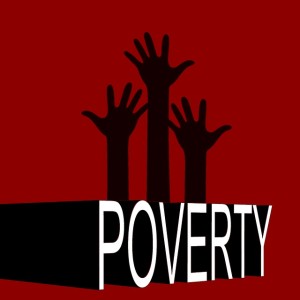Radically Centered: Redefining Poverty
There will always be poverty people, but we seem stuck on trying to win an unwinnable battle. It’s time to redefine the fight.
by Justin Shimko
Last week, I laid out the fundamental problem with increasing the minimum wage. That concept, along with higher taxes for the rich and more economic programs that create negligible results, continues to exemplify why we need to abandon the way we think about poverty and how to restore traditional growth programs that actually lead to continued benefits for everyone, especially those in poverty.
 Currently, we have a poverty level that exceeds the minimum wage, as mentioned last week. If we increase the minimum wage for the 3.3 million Americans who currently earn that level, we do not decrease poverty but instead has the potential to increase the poverty threshold. Looking at the minimum wage rate in the 1950s compared to the percentage of people in poverty, it is easy to see that the change of the wage had no real effect on poverty. In 1950, the minimum wage was 75 cents ($7.37 in 2014 dollars) and the percentage in poverty was 30.2 percent. The federal government did not adjust that wage for five years, which saw the 75 cents drop in value to 6.63. During that time, the poverty population dropped to 24.5 percent. Fast forward five years to 1960 and you have minimum wage at $1 ($8.00 in 2014) but the poverty line dropped just over 2 percent more to 22.2 percent. That doesn’t create much confidence in the way minimum wage improves poverty.
Currently, we have a poverty level that exceeds the minimum wage, as mentioned last week. If we increase the minimum wage for the 3.3 million Americans who currently earn that level, we do not decrease poverty but instead has the potential to increase the poverty threshold. Looking at the minimum wage rate in the 1950s compared to the percentage of people in poverty, it is easy to see that the change of the wage had no real effect on poverty. In 1950, the minimum wage was 75 cents ($7.37 in 2014 dollars) and the percentage in poverty was 30.2 percent. The federal government did not adjust that wage for five years, which saw the 75 cents drop in value to 6.63. During that time, the poverty population dropped to 24.5 percent. Fast forward five years to 1960 and you have minimum wage at $1 ($8.00 in 2014) but the poverty line dropped just over 2 percent more to 22.2 percent. That doesn’t create much confidence in the way minimum wage improves poverty.
The problem we have with poverty today has nothing to do with minimum wage. It has nothing to do with government programs or charitable organizations. It has everything to do with the way we want to combat poverty. We should not try to eliminate poverty but instead try to fix it. Like a broken bone, you do not amputate it but instead mend it.
The concept of eliminating poverty is a fool’s errand. There will always be poor people. Trying to fix that problem does not help them when the problem does not go away. How we treat the poor, however, is how we can make a better life for millions of people in this country.
Look at life in 1900. Then, being poor meant sharing a small apartment with many people (think couch surfing on steroids), surviving on little food and, if they had a job, working in some of the most deplorable conditions. Wages were abysmal, the average annual income was $12,000. Labor laws did not exist, meaning your five-year-old brother went to work selling papers while you, as a 14-year-old girl, went to the factory. The chances for upward mobility were slim - at best - and the ability to earn an education, eighth grade, was rare.
Fast forward 115 years and the opportunities for that basic education is available and embraced by this nation. Being poor for many (not all) means being able to live in a non-studio apartment with basic food needs met and the ability to own a refrigerator and television. But it could mean so much more if we actually work to redefine poverty.
By changing the way we look at life among the bottom 10 percent we can establish a way the poor lives that would not be detrimental for anyone unfortunate to be there. The fear of losing health insurance or eating ketchup soup as a meal would not exist. Instead, the basic needs in life coupled with the real chance to get out of poverty needs to be our foundation for what life in poverty would be like. We don’t pass short-term almost-fixes like minimum wage increases to pull people out of poverty with arbitrary numbers assigned to a job that requires very few, if any, skills. We can’t even do this by taxing the wealthy to pay for ineffective programs that prolong the despair millions of people who climb out of the dark. And it can’t happen if the wealthy horde their assets like they have for the past several years.
So why does minimum wage continue to be touted as the answer to poverty? Because we look at short-term results and expect static growth without looking at long-term consequences. Instead of trying to change the way we pay low-skilled jobs, why don’t we look at ways to actually increase the livelihood of all Americans? Why can’t we return to the old type of job growth where minimum wage jobs increase for high school and college students while skilled jobs, jobs that pull people out of poverty and give them a career, also grow?
Why can’t we work towards a way to redefine what it means to be poor without silly campaign pledges that just perpetuate the problem plaguing Americans for decades?
Justin Shimko is an award-winning writer and political analyst. He began as a reporter in his college days at the University of Oklahoma, writing for The Oklahoma Daily (rated as one of the best collegiate newspapers in the nation) and The Oklahoman, the statewide newspaper, winning awards from the CSPA and the Society of Professional Journalists. He later moved on to research and writing work for a number of political campaigns. His email is
[email protected]
Latest posts by Justin Shimko (see all)
Related
 Blog Posts
Blog Posts





Radically Centered: Redefining Poverty
There will always be poverty people, but we seem stuck on trying to win an unwinnable battle. It’s time to redefine the fight.
by Justin Shimko
Last week, I laid out the fundamental problem with increasing the minimum wage. That concept, along with higher taxes for the rich and more economic programs that create negligible results, continues to exemplify why we need to abandon the way we think about poverty and how to restore traditional growth programs that actually lead to continued benefits for everyone, especially those in poverty.
The problem we have with poverty today has nothing to do with minimum wage. It has nothing to do with government programs or charitable organizations. It has everything to do with the way we want to combat poverty. We should not try to eliminate poverty but instead try to fix it. Like a broken bone, you do not amputate it but instead mend it.
The concept of eliminating poverty is a fool’s errand. There will always be poor people. Trying to fix that problem does not help them when the problem does not go away. How we treat the poor, however, is how we can make a better life for millions of people in this country.
Look at life in 1900. Then, being poor meant sharing a small apartment with many people (think couch surfing on steroids), surviving on little food and, if they had a job, working in some of the most deplorable conditions. Wages were abysmal, the average annual income was $12,000. Labor laws did not exist, meaning your five-year-old brother went to work selling papers while you, as a 14-year-old girl, went to the factory. The chances for upward mobility were slim - at best - and the ability to earn an education, eighth grade, was rare.
Fast forward 115 years and the opportunities for that basic education is available and embraced by this nation. Being poor for many (not all) means being able to live in a non-studio apartment with basic food needs met and the ability to own a refrigerator and television. But it could mean so much more if we actually work to redefine poverty.
By changing the way we look at life among the bottom 10 percent we can establish a way the poor lives that would not be detrimental for anyone unfortunate to be there. The fear of losing health insurance or eating ketchup soup as a meal would not exist. Instead, the basic needs in life coupled with the real chance to get out of poverty needs to be our foundation for what life in poverty would be like. We don’t pass short-term almost-fixes like minimum wage increases to pull people out of poverty with arbitrary numbers assigned to a job that requires very few, if any, skills. We can’t even do this by taxing the wealthy to pay for ineffective programs that prolong the despair millions of people who climb out of the dark. And it can’t happen if the wealthy horde their assets like they have for the past several years.
So why does minimum wage continue to be touted as the answer to poverty? Because we look at short-term results and expect static growth without looking at long-term consequences. Instead of trying to change the way we pay low-skilled jobs, why don’t we look at ways to actually increase the livelihood of all Americans? Why can’t we return to the old type of job growth where minimum wage jobs increase for high school and college students while skilled jobs, jobs that pull people out of poverty and give them a career, also grow?
Why can’t we work towards a way to redefine what it means to be poor without silly campaign pledges that just perpetuate the problem plaguing Americans for decades?
Justin Shimko
Latest posts by Justin Shimko (see all)
Share this:
Related